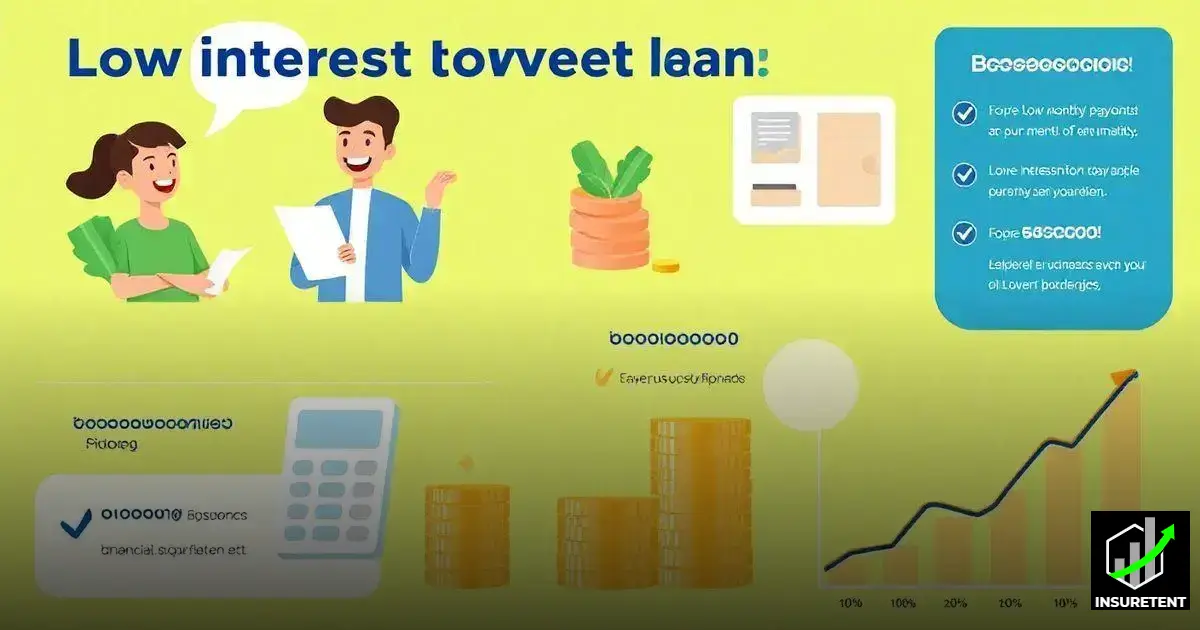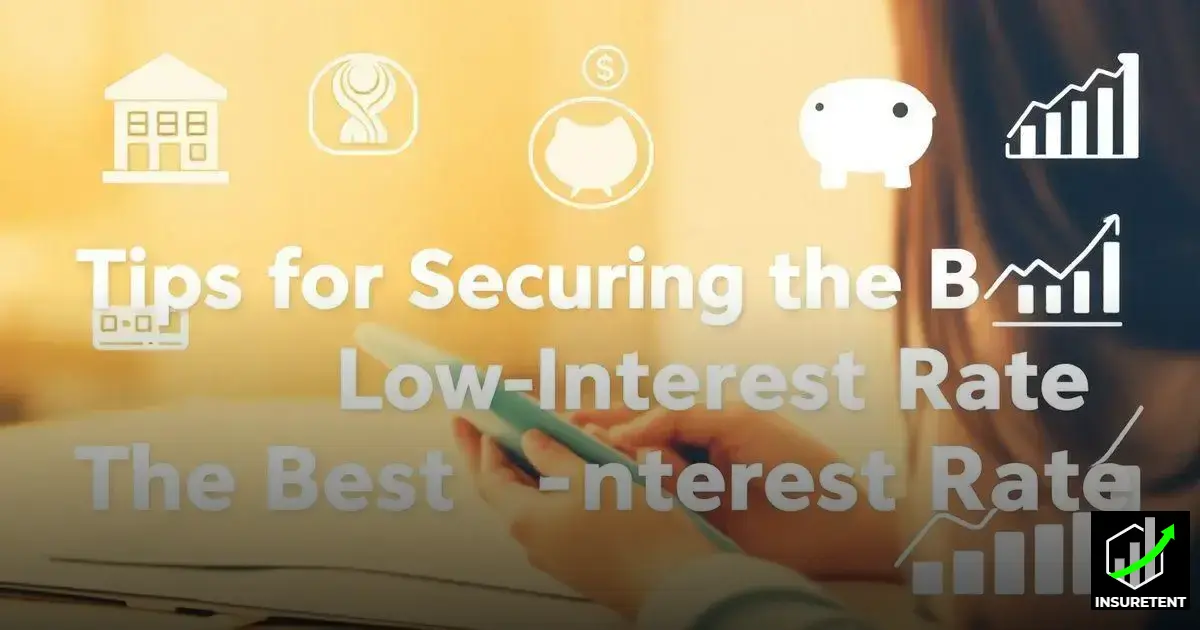Looking for low-interest loan options? You’re not alone! With rising expenses, many people seek financial solutions that offer manageable repayments and cost savings. Low-interest loans can provide relief by reducing monthly payments and minimizing long-term financial strain.
Understanding the different types of low-interest loan options is essential to finding the best fit for your needs. Factors like credit score, loan terms, and lender policies play a crucial role in determining eligibility and overall loan costs. Taking the time to compare lenders and offers can help you secure the most favorable rates and conditions.
How do you choose the right low-interest loan option for your situation? Exploring key considerations, potential benefits, and expert strategies can guide you in making a well-informed financial decision.
What Are Low-Interest Loans?
Low-interest loans are financial products that offer borrowers a lower interest rate compared to standard loans. They are designed to make borrowing more affordable, particularly for those who might struggle with higher rates. These loans can be used for a variety of purposes, including consolidating debt, financing a car, or even paying for home improvements.
Typically, low-interest loans come with fixed or variable rates. A fixed-rate means your interest rate stays the same throughout the loan term, providing predictability in your repayments. In contrast, a variable rate may fluctuate based on market conditions but can start lower than fixed rates, making them appealing for short-term borrowing.
Eligibility for low-interest loans often depends on your credit score and financial history. Lenders assess these factors to determine the risk associated with lending to you. Generally, individuals with higher credit scores qualify for the most favourable rates, while those with lower scores may still access low-interest options but with different terms.
Furthermore, it’s essential to compare various lenders and their offers. While one lender might advertise a low interest rate, additional fees could negate those savings. Always read the fine print and calculate the true cost of borrowing before making a decision.
Benefits of Low-Interest Loan Options

Low-interest loans offer numerous benefits that can help individuals manage their financial responsibilities more effectively. One of the primary advantages of these loans is the reduced repayment amounts, making it easier for borrowers to stay within their budget.
These loans often come with lower monthly payments, which can free up cash for other expenses or savings. This means you can maintain a better quality of life without the stress of high-interest payments. Additionally, low-interest loans may help improve your credit score if managed well. By making on-time payments consistently, borrowers can demonstrate responsible financial behaviour.
Another significant benefit is the opportunity to consolidate existing debt. By using a low-interest loan to pay off high-interest debt, you can streamline your finances and save money in the long run. This is particularly useful for those juggling multiple sources of debt and looking to regain control over their financial situation.
Lastly, low-interest loans may offer flexible terms, allowing you to tailor the repayment period to your needs. Whether you prefer a more extended term for lower payments or a shorter term to pay less interest overall, these options can help you find the right fit for your financial goals.
Types of Low-Interest Loans Available
There are several types of low-interest loans available to borrowers, catering to various needs and financial situations. Understanding these options can help you choose the best fit for your circumstances.
One popular type is the personal loan, which can be used for various purposes like debt consolidation, medical expenses, or home improvements. Personal loans typically offer fixed rates and flexible terms, making them a viable option for many.
Secured loans are another option. These loans require collateral, such as a home or vehicle, which lowers the lender’s risk and, in turn, can result in lower interest rates. However, it’s crucial to understand that failing to repay these loans could result in losing the collateral.
Home equity loans and home equity lines of credit (HELOCs) use your home’s equity to secure a loan. These options generally come with lower interest rates than unsecured loans because they are backed by your property. They can be beneficial for larger expenses, like renovations or education costs.
Another type is the student loan, which is specifically designed to help pay for education. Federal student loans often have lower interest rates compared to private loans and may offer flexible repayment options.
Lastly, there are auto loans, used to purchase vehicles. These loans often come with competitive rates, especially if you’re financing through a dealership.
In conclusion, when considering low-interest loans, explore different types available and evaluate them against your financial goals and needs.
How to Apply for Low-Interest Loans

Applying for low-interest loans can be a straightforward process if you follow the right steps. First, it is essential to assess your financial situation. Take a close look at your credit score and financial history, as these factors will significantly influence the loan terms you can secure.
Next, research potential lenders to find those that offer low-interest options. This includes traditional banks, credit unions, and online lenders. Review their rates, terms, and eligibility requirements to ensure you are well-informed.
Once you have identified suitable lenders, gather the necessary documentation. This may include proof of income, identification, and any financial statements to demonstrate your ability to repay the loan. Having these documents ready can make the application process smoother.
After preparing your documentation, fill out the loan application either online or in-person, depending on the lender’s procedures. Be honest and thorough when providing your information, as discrepancies can delay approval.
Following your application submission, the lender will review your request. This may involve a credit check and verification of your financial information. Be prepared to answer any follow-up questions they may have.
If approved, carefully review the loan offer. Look for the interest rate, loan amount, repayment terms, and any additional fees. Make sure you understand all aspects of the agreement before accepting it.
Finally, once you accept the loan, ensure that you adhere to the repayment schedule. Set reminders for payments to avoid late fees and keep your financial health in check.
Criteria for Qualifying for Low-Interest Loans
Qualifying for low-interest loans involves meeting specific criteria set by lenders. The first and most crucial factor is your credit score. Lenders typically require a good credit score, often above 650, to consider you for low-interest rates. A higher score indicates responsible borrowing behaviour and reduces the lender’s risk.
Another important criterion is your debt-to-income ratio. This ratio compares your monthly debt payments to your gross monthly income. Most lenders prefer a debt-to-income ratio of 36% or lower. Keeping your debts manageable will improve your chances of qualifying.
Employment history also plays a role in the qualification process. Lenders look for stable employment with a consistent income. Generally, having a job for at least two years in the same field can positively impact your application.
Additionally, lenders may assess your financial stability, which includes savings and assets. Having a stable financial background demonstrates your ability to repay the loan. It is beneficial to have some savings as a backup, as it reflects responsibility.
Lastly, it is advisable to research and compare different lenders. Each lender has its own set of qualification standards, so exploring multiple options can help you find the best fit for your situation. Knowing the specific qualifications required by each lender can streamline the application process and increase your chances of approval.
Comparing Low-Interest Loan Providers

When comparing low-interest loan providers, it is essential to examine several key factors to ensure you make an informed decision. The first factor to consider is the interest rate. Different lenders offer varying rates, and even a small difference can significantly impact the overall cost of the loan. Always look for the lowest possible rate that fits your needs.
Next, pay attention to the fees associated with the loan. Some lenders may charge origination fees, processing fees, or prepayment penalties that can add to your costs. Make sure to read the fine print and understand all fees before committing.
Loan terms are another vital aspect to compare. Check the repayment period, as longer terms can lead to lower monthly payments but may result in paying more interest over time. Determine which repayment structure aligns best with your financial situation.
The lender’s reputation also plays a crucial role in your decision. Research online reviews and ratings from other customers. Reliable lenders will have positive feedback regarding their customer service and loan processes. Look for lenders that offer transparent communication and support throughout the loan term.
Additionally, consider the application process. Some lenders may have a more streamlined, user-friendly process compared to others. Choosing a lender with a straightforward online application can save you time and frustration.
Lastly, explore any additional features that lenders may offer. Some may provide options for flexible repayment or the ability to defer payments in certain situations. These features can provide added peace of mind.
Tips for Securing the Best Low-Interest Rate

Securing the best low-interest rate involves several strategic steps that can improve your chances of getting a favourable deal.
First, it’s essential to check your credit score. A higher credit score often translates to lower interest rates. Consider requesting a copy of your credit report and reviewing it for accuracy. If your score is low, take steps to improve it before applying.
Another important tip is to shop around. Different lenders offer varying rates, so compare multiple options to find the best deal. This can include banks, credit unions, and online lenders. Don’t hesitate to negotiate terms with potential lenders, as they may be willing to lower rates to secure your business.
Consider the loan type as well. Secured loans, which require collateral, often provide lower rates than unsecured loans. If you have an asset to back the loan, this could be a beneficial route to explore.
Additionally, be mindful of the loan term. Shorter loan terms often come with lower interest rates, which can save you money in the long run. However, be sure that you can afford the higher monthly payments that typically accompany shorter terms.
Lastly, timing can play a critical role. Interest rates fluctuate based on economic conditions. Keeping an eye on market trends and applying when rates are low can significantly impact the rate you secure.
By taking these steps, you can greatly enhance your chances of obtaining the best low-interest rate available.
Making Informed Decisions for Low-Interest Loans
When considering low-interest loan options, it is important to understand the various types available, the criteria for qualification, and how to compare different lenders.
By conducting thorough research and keeping your financial health in check, you can find a loan that meets your needs and offers favourable terms.
Remember to focus on factors like interest rates, fees, and terms to make the best choice.
Low-interest loans can be powerful financial tools if used wisely, enabling you to achieve your financial goals without being burdened by high costs.
Ultimately, being informed and prepared will empower you to navigate the loan landscape successfully.
Check out our article on Home Insurance to learn how it can protect your home and belongings from unexpected events.
